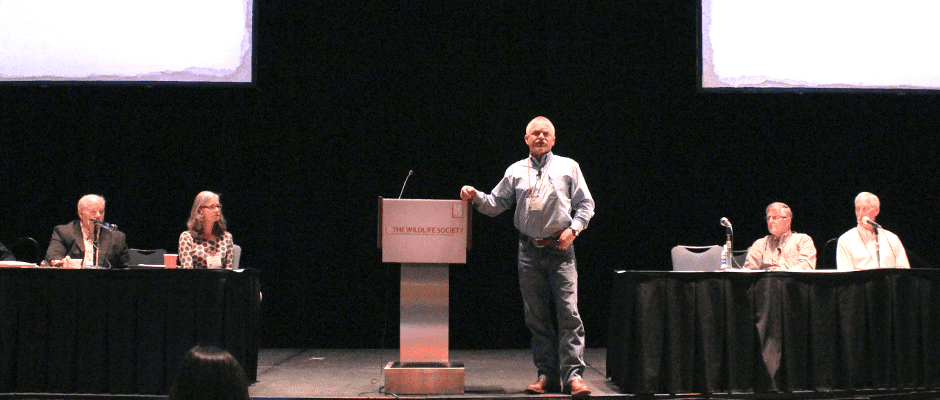Share this article
Landowners and agency biologists showcase public-private partnerships
With nearly 70 percent of U.S. land owned by private individuals and entities, it’s clear that conservation work must include private landowners. The Partners for Fish and Wildlife Program is making great strides toward that goal, working with landowners to develop cooperative conservation solutions. In the Wednesday morning keynote event at TWS’ 23rd Annual Conference in Raleigh, N.C., speakers explained how they are overcoming traditional frictions to forge new partnerships.
“I’m able to present ideas to these landowners that interest them, and I’m able to find them some cost shares, and we gain each other’s trust,” said John Ann Shearer, a fish and wildlife biologist with the USFWS Raleigh Ecological Services Field Office and one of the program’s coordinators. “Relationships — not needs, not laws, not rules, not even species, but relationships — determine the success that follows.”
After Shearer introduced the Partners for Fish and Wildlife Program, three ranchers told their own stories of working with the USFWS biologists.
Jim Stone described conservation work in and around his family’s ranch in the Blackfoot watershed in western Montana. Stone said he manages his ranch based on the health of the fisheries.
“We’re finally figuring out that when it’s clean, cool, connected, healthy riparian zones — healthy timber, healthy grass — guess what we’re doing? We’re raising more pounds of beef,” he said.
Stone’s conservation efforts go beyond the boundaries of his own land. He is part of the “Blackfoot challenge,” a cooperative team of landowners and biologists working to protect the watershed as sustainably managed working land. The partnership now encompasses 1.25 million acres of the 1.5-million-acre watershed, an astounding feat given the region’s diverse and complex ownership, said Stone.
The next landowner to tell his story was David “Leftie” Durando, a member of the Northern Everglades Alliance who helped establish the Everglades Headwaters National Wildlife Refuge and Conservation Area. Durando credited USFWS biologist Erin Myers with helping him trust the government agency and commit to protecting wildlife such as the endangered Florida grasshopper sparrow (Ammodramus savannarum floridanus). Restoring habitat for the sparrows involves cutting down trees to promote grasslands, something Durando said he wouldn’t have done on his land in the past.
“I promise you, if you’d come near one of [my trees] with a saw, I’d have run you off the joint,” he said. But, he said, after building a partnership with Myers and the USFWS, “we knew we had to create habitat for that little guy, because he doesn’t like high things.”
The final landowner to take the stage was Terry Mansfield, who raises “sheep, cattle and kids” on his ranch in Washington. Mansfield comes from a wildlife biology background, and has more than 33 years of experience working for state wildlife agencies. He described the conservation work he is doing on his own land, setting up a conservation easement and restoring a portion of wetland habitat with native plant species.
“To a degree, this is kind of a showcase,” he said. “This is a place that I can bring my neighbors and talk about the potential.”
“We simply have to have private lands to sustain our wildlife populations,” said Shearer. “This is the recognition that wildlife don’t know boundaries, and this is the recognition of landscape-scale conservation.”
At the conclusion of the program, all the speakers agreed that their experience with the partnership demonstrated that agencies and landowners really can work together to conserve wildlife and ecosystems.








